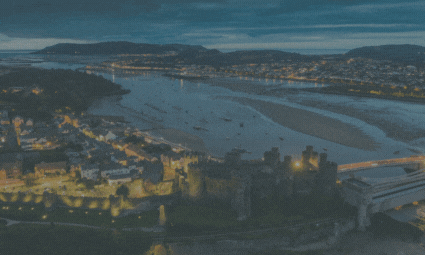The Slate Landscape of Northwest Wales has become the UK’s newest UNESCO World Heritage Site, having been granted the accolade yesterday, at the 44th session of the World Heritage Committee.
The landscape has become the UK’s 32nd UNESCO World Heritage Site and is the 4th in Wales, following the Pontcysyllte Aqueduct, Blaenavon Industrial Landscape and the Castles and Town Walls of King Edward in Gwynedd.
The Slate Landscape of Northwest Wales, which runs through Gwynedd, became the world leader for the production and export of slate in the 1800s. Slate has been quarried in the area for over 1,800 years and had been used to build parts of the Roman fort in Segontium in Caernarfon and Edward I’s castle in Conwy, however it wasn’t until the industrial revolution that demand surged as cities across the world expanded with slate from the mines at Gwynedd being widely used to roof workers’ homes, public buildings, places of worship and factories.
By the 1890s the Welsh slate industry employed approximately 17,000 workers and produced almost 500,000 tonnes of slate a year, around a third of all roofing slate used in the world in the late 19th century. The industry had a huge impact on global architecture with Welsh slate used on a number of buildings, terraces and palaces across the globe including Westminster Hall in London’s Houses of Parliament, the Royal Exhibition Building, Melbourne, Australia and Copenhagen City Hall, Denmark. In 1830, half the buildings in New York had roofs made of Welsh slate.
Centuries of mining in the area transformed the landscape on a monumental scale with the inscription reflecting the important role this region played in ‘roofing the 19th century world’.
UK Government Heritage Minister Caroline Dinenage said:
“UNESCO World Heritage Status is a huge achievement and testament to the importance this region played in the industrial revolution and Wales’ slate mining heritage. I welcome the prospect of increased investment, jobs and a better understanding of this stunning part of the UK.”
The City of Bath – originally inscribed on the Word Heritage List in 1987 – has also been awarded a dual designation as part of the Great Spas of Europe.
A transnational nomination, Bath, along with 11 other European spa towns including Baden-Baden in Germany and Vichy in France, has been added to the UNESCO World Heritage List for the second time, becoming only the second place in the UK with a double UNESCO listing.
The 11 towns making up the nomination are all mineral water sources. While Bath has been famous as a spa town since the Roman period, other nominations represent the heyday of European spa towns from around 1700 to the 1930s.
Duncan Wilson, Chief Executive of Historic England said:
“We are pleased to see both the Slate Landscape of Northwest Wales and the city of Bath being recognised in the UNESCO World Heritage List. Beautiful Bath thoroughly deserves its rare double World Heritage Site listing. From its Roman remains to its stunning Georgian architecture, Bath is a city which has captivated residents and visitors for centuries. Being inscribed, along with ten other European Spa Towns, as a joint World Heritage Site demonstrates Bath’s importance as one of the earliest and most significant “Great Spas” and we are delighted to have worked alongside international colleagues to make Bath’s joint inscription a reality.”
UK Government Minister for Wales David TC Davies said:
“Achieving UNESCO World Heritage Status is a magnificent accomplishment and a great tribute to those who worked in these slate mines. I’d like to commend everyone involved for their commitment to ensuring Wales’ slate mining heritage and the role this region has played for 1,000 years receive the global recognition they richly deserve.”
First Minister of Wales Mark Drakeford said:
“Today’s announcement recognises the significant contribution this part of North Wales has made to the cultural and industrial heritage not only of Wales, but of the wider world. Welsh slate can be found all over the world.
“The quarrying and mining of slate has left a unique legacy in Gwynedd, which the communities are rightly proud of. This worldwide recognition today by UNESCO, will help preserve that legacy and history in those communities for generations to come and help them with future regeneration.
“I’d like to thank and congratulate everyone who has worked so hard on this bid – it’s been a real team effort and today’s announcement is a credit to all those involved.”
David Anderson, Director General, Amgueddfa Cymru – National Museum Wales said:
“Amgueddfa Cymru – National Museum Wales is very proud to have been a key partner in this bid and is delighted at the successful designation of the slate landscape of northwest Wales as a World Heritage site. Its success will ensure that the impact of the culture and industrial heritage of the area – including the story of the slate industry which we tell at the National Slate Museum in Llanberis – is recognised throughout the world. We have a rich and diverse heritage in Wales and this is a great opportunity to celebrate and showcase our cultural heritage on an international stage and will help preserve the legacy and history in communities for generations to come. Congratulations to all those who have worked so hard on this bid – today’s announcement is a credit to all those involved.”
Kate Pugh OBE, Non-Executive Director for Culture at the UK Commission for UNESCO, said:
“This UNESCO inscription is a magnificent achievement comparable to the effort and perseverance of the people who lived in these awe-inspiring places and worked these slate mines. UNESCO World Heritage Site status calls for a galvanising vision, and everyone from Gwynedd Council, its partners and the people now living in those historic settlements should be commended for their solid commitment to getting the global recognition that their landscape well deserves.”
Lord Dafydd Wigley, Chair of the Wales Slate Partnership Steering Group, said:
“After Chairing the Wales Slate Partnership Steering Group for over 5 years, I am thrilled by this decision by the World Heritage Committee and welcome our inscription on behalf of all our partners, landowners, communities and businesses.
“Partners have worked tirelessly over more than a decade to reach this important milestone, and we will now need to strengthen our cooperation to ensure that we deliver for the people, communities and businesses of the slate areas. This inscription is a celebration of Gwynedd roofing the world, our unique language, culture and communities and how we exported people, technology and slate to the four corners of the world.
“I would like to pay my thanks to all involved in developing this inscription and offer my congratulations to the newest World Heritage Site in Wales”.
Councillor Dyfrig Siencyn, Leader Gwynedd Council, said:
“Gwynedd Council is extremely proud to be the lead body for the Slate Landscape of Northwest Wales. The legacy of the quarries remains extremely evident around us from the striking landscape, the industrial buildings and steam railways to our villages and towns.
“Not only is the influence of the quarrying industry visible, but its heritage is still heard strongly in the language, traditions and rich histories of these areas.
“Our aim is to celebrate this heritage and landscape and recognise their historic and industrial importance to humankind – in order to create opportunities for the future”.
Councillor Gareth Thomas, Cabinet Member for the Economy and Community, Gwynedd Council, said:
“The slate industry of this area was a hugely important part of the global economy in the past, and today the industry and those that gain inspiration from our landscape continue to make an important contribution to Gwynedd’s economy.
“By celebrating our history, we want to regenerate our communities and create exciting opportunities for the benefit of the communities and businesses of Gwynedd and Northwest Wales in the future.
“Today we celebrate what has happened in the past and start on a new journey to protect our outstanding slate landscape and ensure a lasting legacy for our economy and communities in the future”.
Christopher Catling, Secretary of the Royal Commission on the Ancient and Historical Monuments of Wales, whose staff helped to compile the nomination document, said:
“Human muscle and ingenuity have left us with a remarkable landscape combining natural and man-made features that are fully worthy of being included in the top tier of all heritage sites in the world.
“Here you can see the evidence for the entire slate production process, from hillside quarry and cavernous underground mines to the engine houses, wheelhouses and mills powered by ingenious water systems needed to work the slate; the inclines and aerial ropeways used to carry raw and worked slate from remote hills to tramways, and the narrow-gauge railways capable of negotiating mountainous terrain carrying slate to the harbours at Port Penrhyn and Porthmadog for shipment to all parts of the world.”
Tony Crouch, Chair World Heritage UK
“World Heritage UK warmly welcomes the Slate Landscape of Northwest Wales to the UK’s family of World Heritage Sites. This monumental landscape reflects hundreds of years of endeavour, innovation, and community spirit, and produced the finest materials and skills that served the globe. Congratulations to all those in Wales who worked tirelessly to achieve this well-deserved international accolade.”
Luke Potter, Assistant Director of Operations in North Wales, National Trust Cymru said:
“We’re thrilled to be a part of Wales’ next World Heritage Site; the designation means so much to us at National Trust Cymru. We have important stories at Penrhyn of slate as well as sugar, and slavery. Being part of the designation is an exciting opportunity for us all to work with partners to unite these two stories that have shaped the communities around us and have a far-reaching impact on communities across the world. We have already benefited greatly from being part of the development of the nomination and really see the importance of working together to tell this important story that belongs to us all in Northwest Wales and beyond.”
Jonathan Cawley, Director of Planning and Land Management for the Snowdonia National Park Authority, said:
“We are extremely pleased that the slate landscape of North Wales has secured its World Heritage Site status today. The slate industry has shaped and influenced so much of our landscape and traditions, and this inscription will ensure that the unique cultural heritage of the area will be protected and celebrated for years to come.
“As well as helping to boost a sustainable economy within the area, this designation will also nurture an awareness, interest and pride in our slate heritage, whilst safeguarding it for future generations.”






